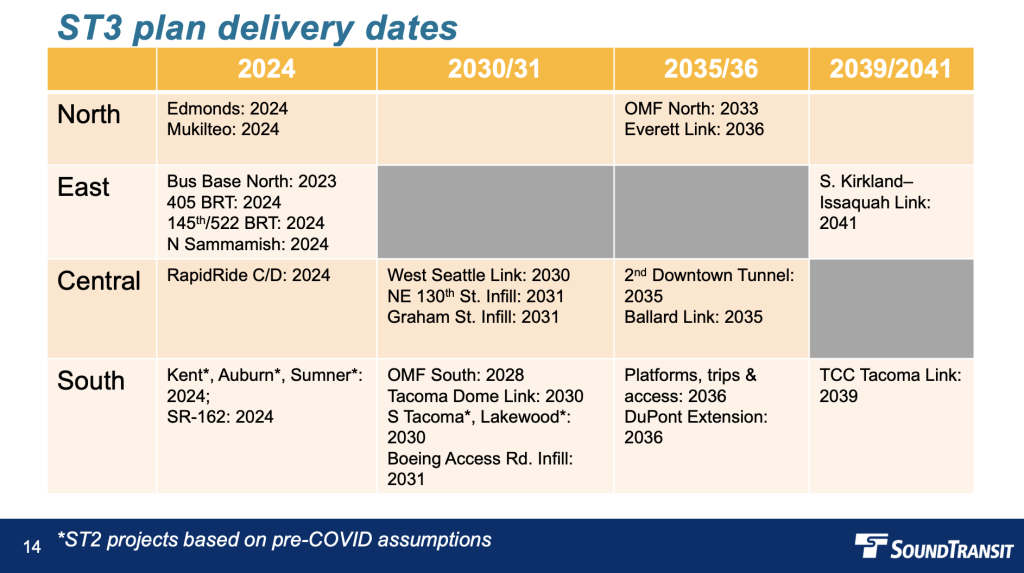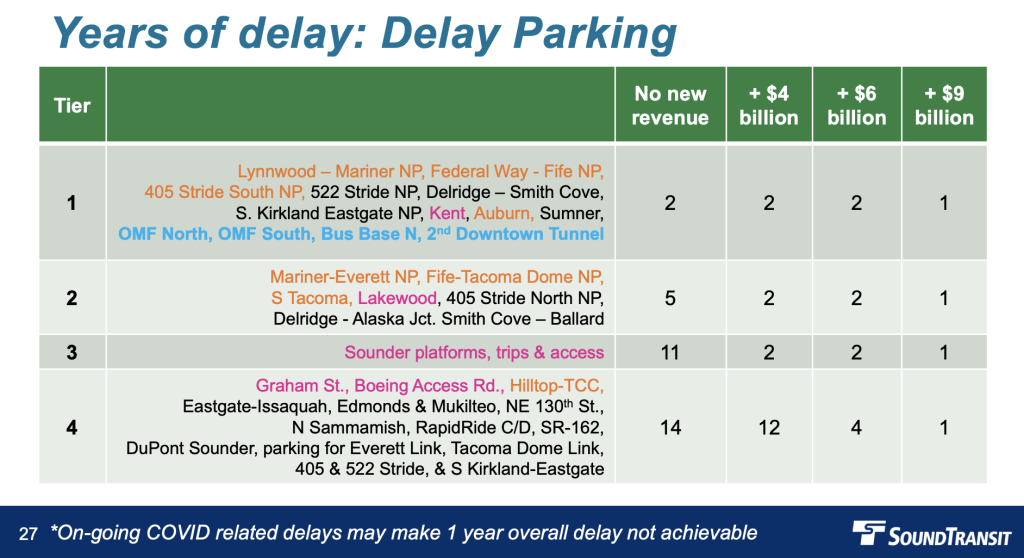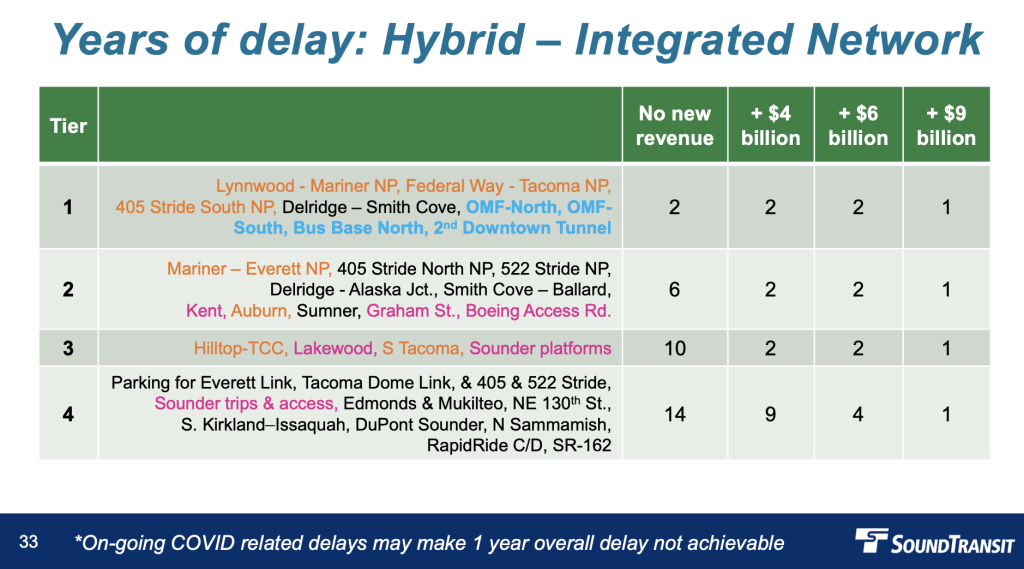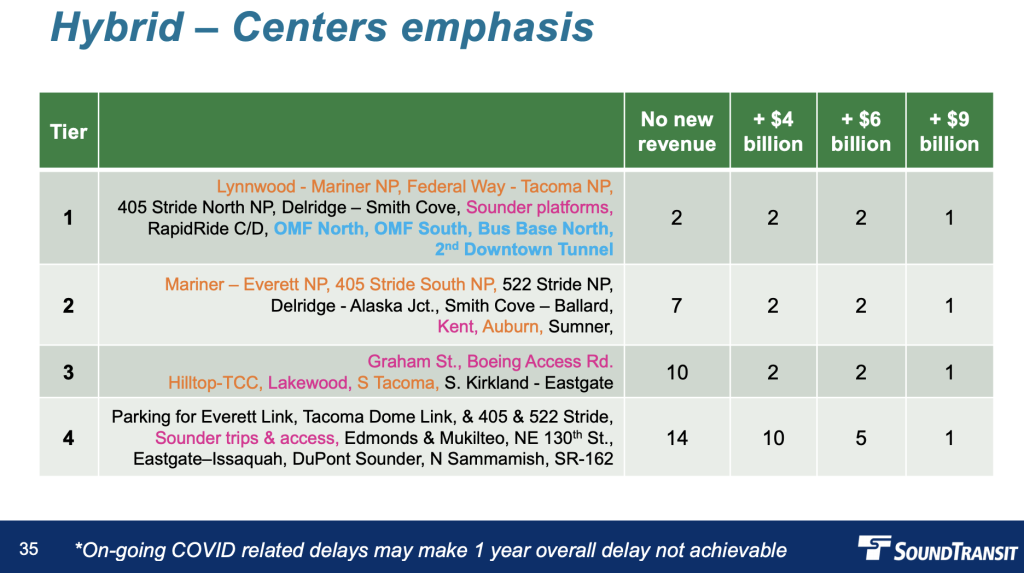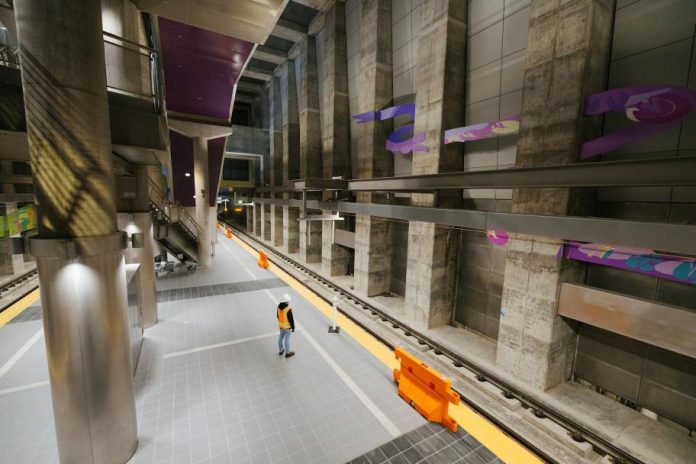
In some encouraging news yesterday, Sound Transit shared an updated financial outlook for Sound Transit 3 (ST3). Revised projections show that the program affordability gap has narrowed by $3.6 billion from $11.5 billion down to $7.9 billion. However, there remains some disagreement about how to proceed with program realignment to create an affordable plan. A letter by high-profile boardmembers was sent in advance of yesterday’s meeting that urged a change to the program realignment process, including a delay of big decisions until 2022.
Affordability gap changes and cost drivers
On the financial side, the affordability gap has mostly shrunk due to improved tax revenue projections. The revisions assume an additional $4.6 billion in tax revenue through 2041. There is a high level of uncertainty in the number though and the overall tax revenue loss over the period is still assumed to be $1.5 billion compared to pre-pandemic projections. The American Rescue Plan that passed in March will deliver another $527 million in grants ($275 million in formula grants and $253 million for Federal Way and Lynnwood Link extensions) to Sound Transit. These financial improvements, however, were tempered by another $595 million in additional capital costs from inflation and revisions to infill station cost assumptions.
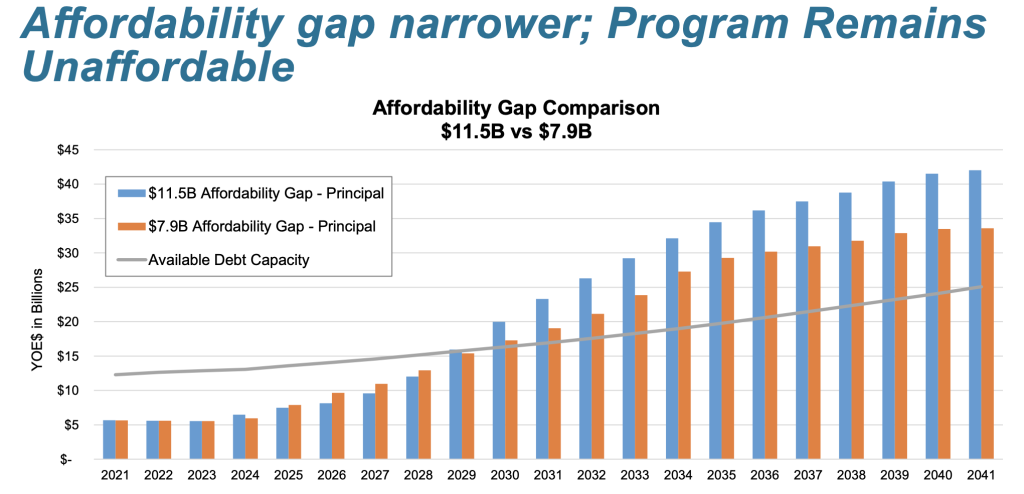
Overall, these financial forecast improvements could make program realignment a little easier having a 30% smaller budget hole. But there is still caution here given that the revenue forecast is unlikely to get much rosier while escalating project costs continue to be the primary driver of the affordability gap and could continue to spiral without intervention.
To cover the gap, the agency’s board does have a variety of tools that could be used to create a financially balanced plan:
- The board could pursue its own taxing authority options like seeking approval for an increase in the debt capacity limit (high impact), imposing an employer head tax (modest impact), and increasing the rental car tax (low impact);
- The board could also delay, modify, or (in the worst case) cut projects in the program (the latter has all but been ruled out); and
- The board could seek third-party funding.
The latter tool has obviously been lucrative and there is potential for more near-term federal grants as the Biden administration pursues the $2.25 trillion American Jobs Plan — a transit-friendly infrastructure plan that has pegged $85 billion for public transportation. Agency staff were quick to point out that state grants could be an option, too, but the state legislature has no imminent plans to offer grants to Sound Transit. Traditionally, the state legislature has barred the agency from receiving capital grants.
Looking at new cost drivers, agency staff detailed changes in capital program assumptions. What that showed was that inflation increased project costs a further $1.16 billion ($1.03 billion from the construction cost index and $130 million from consumer price index). Countervailing this was better cashflow, which reduced capital cost assumptions by $716 million. Nevertheless, infill station project cost estimates unveiled another $154 million capital hit. This left the overall capital cost estimates increasing another $595 million.
By the way, the infill stations seeing cost increases include Graham Street Station ($12 million cost increase), NE 130th Street Station ($64 million cost increase), and Boeing Access Road Station ($78 million cost increase). Agency staff blamed NE 130th Street Station’s cost increases on “cost premium for construction around live rail operations” and “desired choices to improve rider experience.” Forthcoming meetings are planned to dig deeper into the NE 130th Street Station and Boeing Access Road Station. Seattle Councilmember Debora Juarez — who represents the area around the NE 130th Station — had already requested a meeting on her area’s infill station. King County Councilmember Joe McDermott also asked for one on the Boeing Access Road Station since he represents that area.
Joint letter on program realignment process changes
In advance of the meeting, King County Executive Dow Constantine, Seattle Mayor Jenny Durkan, and King County Councilmember Claudia Balducci sent a lengthy letter to Kent Keel, chair of the board, on suggested changes to the program realignment process. A chief request is to essentially delay big decisions on program realignment until July 2022 — a year later than the current process envisions.
“We request development of a new scenario to extend the realignment process until July 2022, while taking select near-term actions in 2021,” the letter states. “This scenario will allow the board to examine the pros and cons of extending realignment until additional information is available, including the prospect of acquiring additional new revenues, the benefits of a clearer economic picture, identifying new flexible approaches to station access, incorporating additional information about the nature of capital cost increases and conducting meaningful public engagement.” The basic argument is that extending the process will help the board make more informed decisions instead of making quicker decisions on limited information when the cost environment is rapidly changing — in this case improving somewhat.
The letter also outlines three other requests, including working with other agencies on additional financing opportunities, extending and expanding the third-party cost review work to include all Sound Transit 3 projects and projects currently under construction, and aligning realignment solutions with the primary problem of project cost increases.
In terms of additional financing opportunities, the letter states that the signatories “would appreciate an opportunity for [their] City and County financial and planning staff to collaborate with Sound Transit to explore realignment financial scenarios and assumptions” and discuss “likely changes to debt service assumptions due to some projects already seeing a minimum of one to two years delay, about options for moving forward on paused projects now, and about financing opportunities by extending the financial plan to 2043 or 2046.”
For third-party review, a look at all Sound Transit 3 projects could help with making recommendations to control and lower project costs while evaluating all projects under construction could help illuminate a trend of how initial cost estimates change over time as a project proceeds through the 10%, 30%, and 60% design milestones. Running the review process through summer 2022 could “help identify opportunities for lower cost solutions, including reviewing assumptions about the location of land acquisitions and the increased size of land acquisition needs,” the letter concludes.
Lastly, the letter points out that tax revenues are no longer the main affordability gap problem but rather unforeseen project cost increases and that the realignment solution needs to tackle this problem. The letter mostly asks questions in regard to this: “Are the assumptions that led to cost increases in the evaluated projects likely to lead to increases in the remaining realignment portfolio? What has been the average cost increase in recent projects? How should the agency approach a cost-related gap differently than a revenue-related gap?” In the coming months, more answers to these questions may be forthcoming.
Parking remains a key area to salvage the ST3 program
Also in advance of the meeting, a broad coalition of organizations for transit access signed on to a letter encouraging that the board take a look at parking priorities in the program. “While we want to remain true to the spirit of the package, realignment is an important time to take stock of the future and where we are going as an organization in terms of equity and sustainability,” the letter states. “We support delaying parking structures in favor of more affordable and environmentally sustainable access that allows us to move light rail investments forward as soon as possible. If not, we are at risk of delaying — or canceling — the mobility of hundreds of thousands of people in the Puget Sound all for less than 1-2% of the system’s users.”
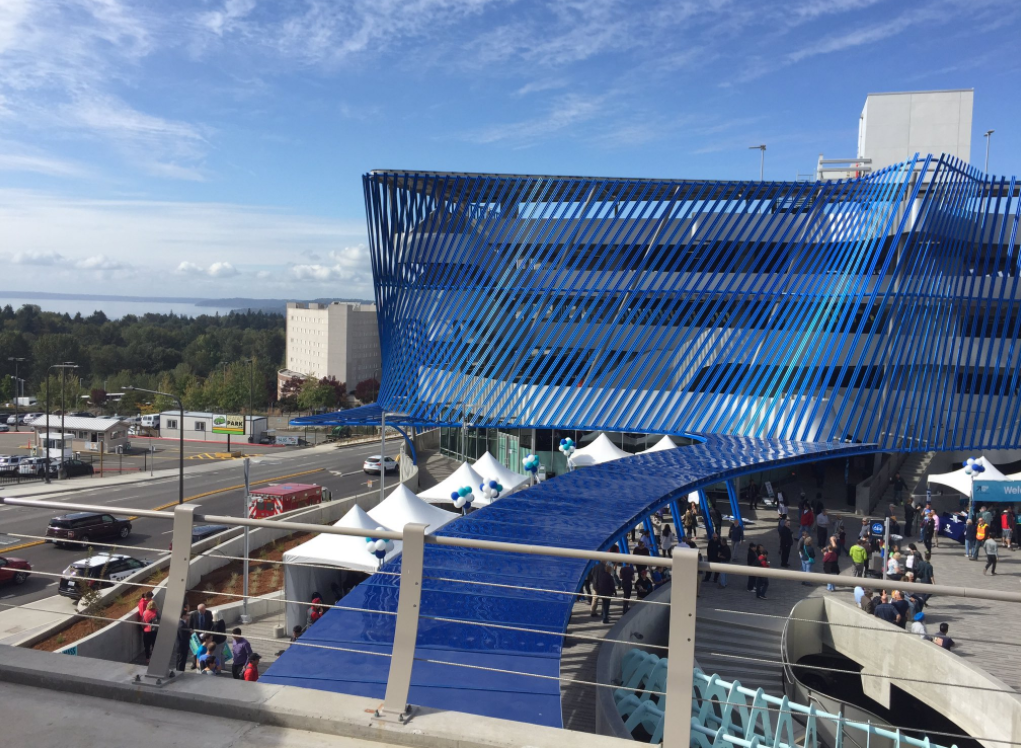
The coalition wants Sound Transit to complete a system access analysis that was contained in the original Sound Transit 3 ballot measure language, which stated: “Sound Transit will evaluate potential locations for parking before implementing projects, including an analysis of access demand and how the investment will conform to surrounding land uses; opportunities for leased or shared parking; and/or parking built in conjunction with new TOD projects.” The coalition also wants the board to update the System Access Plan “with equitable engagement, and using it in concert as a transparent and policy-based approach for directing these funds.”
Organizations that joined in the letter include: Transportation Choices Coalition, Disability Mobility Initiative, Disability Rights WA, Greater Redmond Transportation Management Association, Feet First, Cascade Bicycle Club, Futurewise, Transit Riders Union, Snohomish County Transportation Coalition (SNOTRAC), and Downtown: On the Go!
Based upon information that agency staff has presented to the board, the argument to cutback or delay parking projects is a very strong one, especially in light of improved financial projections. Taking action to deprioritize parking projects could buy back years in the battered Sound Transit 3 capital program for light rail projects.
In the slider below, several years of delay scenarios — as compared to the baseline expansion plan — reprioritizing Sound Transit 3 projects and delaying parking are shown based upon the affordability gap level. The baseline delay scenarios are with no new revenue, but given that the agency has bought back nearly $4 billion in financial capacity, the “+ $4 billion” scenarios are effectively the baseline now. Buying back another $2 billion to $5 billion could move projects up even further with lowered years of delay.
Fundamentally, delaying or cancelling the $1 billion in parking projects could be a very effective strategy in reducing delays to transit projects. Paired with other tools like third-party funding (i.e., federal, state, and local), additional regional taxes, and making good project scope and alignment decisions, the program could become affordable and perhaps better than originally envisioned.
Stephen is a professional urban planner in Puget Sound with a passion for sustainable, livable, and diverse cities. He is especially interested in how policies, regulations, and programs can promote positive outcomes for communities. With stints in great cities like Bellingham and Cork, Stephen currently lives in Seattle. He primarily covers land use and transportation issues and has been with The Urbanist since 2014.

